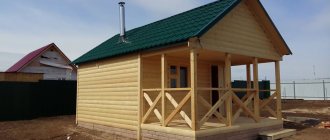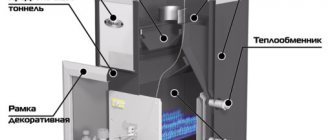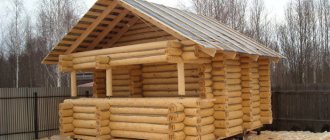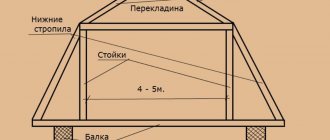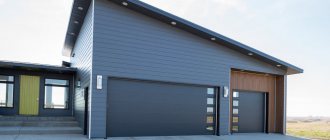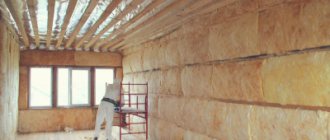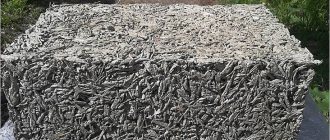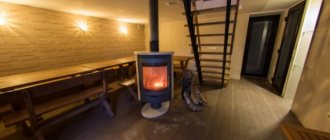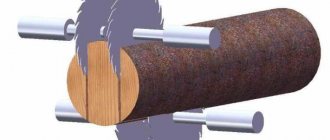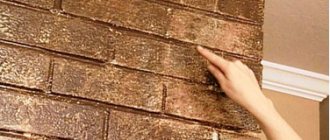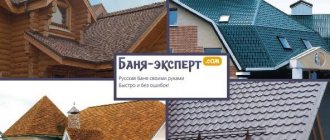Installing heated floors in a bathhouse under tiles is a popular solution, since this type of heating improves the microclimate in the bathhouse and has a number of other advantages. Despite the fact that such a heating system is not cheap, it pays for itself in the future. The ability to quickly dry all surfaces can also be considered a plus, resulting in an increase in the service life of finishes and floors.
Currently, there is a wide variety of options for types of heated floors. They all have their positive and negative sides and installation features.
. In this article, we will examine in detail the question - what type of heated floors are best suited for a bathhouse under tiles. And to understand this, you should familiarize yourself in detail with all their types.
Advantages and disadvantages
When installing a heated floor, the air is heated evenly and this completely eliminates the appearance of a convective draft, which is observed with radiator heating.
An electric floor helps in cases where the bathhouse is located far from gas lines. It has a number of advantages over other types of heating:
- Thermal insulation provided when installing a heated floor prevents heat from passing through it. Thanks to it, up to 40% of heat is retained.
- The installation process, if organized correctly, takes little time.
- Reducing the cost of heating itself, because unlike its centralized counterpart, it is turned on only when using the bathhouse, and not every day.
- All installation work can be carried out independently.
The disadvantages of heated floors include:
- electromagnetic radiation;
- expensive electricity (but this is a relative minus, since the bathhouse is not constantly heated).
In the steam room
Do you need heated floors in a steam room? Previously, baths were made of logs, and there was no foundation. Constant exposure to moisture meant that they often needed to be replaced with new ones.
Then they began to build baths on the foundation. The floors are made of concrete, which is covered with wooden flooring on top. Concrete has high thermal conductivity and is constantly cool. This leads to stagnation of moisture under the wooden flooring and a decrease in its shelf life.
Warm floors are an excellent solution to this problem. With its help, excess moisture quickly evaporates, and also minimizes the likelihood of mold and mildew.
The air in the steam room has a high moisture content, so the use of an electrical system is permissible only if certain rules are observed:
- the circuit must be grounded;
- install special devices for protective shutdown;
- It is required to use a cable designed for rooms with high humidity, which has a special protective coating.
It is not allowed to use an electric floor that is not intended for use in conditions of high humidity.
Equipment for a water-heated floor requires significantly lower costs, since no additional protection against electric current is required. Its use in a steam room is safe.
It is most advisable to use a film infrared heated floor for a steam room. It is quite easy to install. For a water floor, you need to install a boiler, which will need to be constantly heated and you will have to wait a long time for the screed to dry.
Taking this into account, installing an infrared heated floor is more economical, because it will only work when using a bathhouse.
Laminate and parquet are clearly not suitable as a floor for a steam room. But it’s worth considering the use of wood and ceramic tiles.
It is allowed to heat wooden boards with warm floors up to 27°C. With higher heating, the boards dry out, so it is necessary to adjust the heating at a level of about 2/3 of the total power.
Ceramic tiles are the most environmentally friendly and frequently used coating option. The tiles withstand heating and cooling well and will last for many years.
Installation
It’s quite easy to install a heated floor in a steam room without involving builders, with your own hands.
For water heated floors, pipes are used that are mounted between the screed and the floor covering. The aluminum foil backing increases heat transfer. Typically, pipes are laid in a “snake” or “snail” pattern.
“Snail” is great for small rooms in which one circuit is installed. In spacious rooms where installation of several circuits is necessary, it is more rational to use a “snake” installation.
It is recommended to use a step of 30 cm when laying, since a closer arrangement will lead to excessive consumption of pipes, and a further distance will lead to uneven heating of the surface.
To install an infrared floor, perform the following steps:
- the required amount of infrared film is calculated;
- sections are carefully isolated;
- clean the surface of debris;
- lay a layer of thermal insulation;
- arrange the parts of the film according to the previously drawn up diagram;
- fix them together using construction tape;
- connect the film to the power cable, securing it with special clamps;
- insulate the entire joint with special impregnation to prevent moisture from entering;
- check the resistance level;
- covered with floor covering on top.
Pros and cons of operation
The advantage of a water heated floor is much lower electricity consumption than when using infrared film.
The downside should be noted:
- installation complexity;
- the need for constant heating;
- Problematic repairs when a pipe breaks.
Advantages of using infrared film:
- its cost-effectiveness, since constant operation of the system is not required;
- ease of installation.
Types of underfloor heating systems
In the bathhouse, all the same systems are used as in ordinary housing.
Water
Its design, consisting of a closed loop, is laid below floor level. It involves pipes in which hot water or antifreeze circulates under pressure pumped by a special pump.
The coolant is heated to a set temperature using an electric or gas boiler.
We also recommend looking at - Warm water floor under tiles: installation instructions
Electric
This system is better known as a “warm floor”, which consists of special heating sections. The expenses for arranging such a floor with daily use will return after 6 years, but for a bathhouse they will pay off much earlier.
Installation of such a coating will take only a week.
Infrared
This option is distinguished by its electrical safety and airtight design; infrared mats are laid on the sauna floor. Their gentle operating mode allows the use of such floors in wooden structures, such as baths.
At the same time, the height of the room is not lost, since laying such a floor will only require a couple of centimeters.
Installation
Before carrying out it, you should check the sealing of walls, window openings and doors. Then you will need to prepare the base; it must be level. Using a level, check the flatness of the base; if there are deviations, then eliminate them by performing a screed.
Initially, a location for installing the thermostat and access to communications are selected, if we are talking about electric heating; in the case of water heating, the location of the boiler, pipes and taps should be considered.
The installation work is different for each heating system and is described in more detail below.
Wet floor
Installation begins with the selection and organization of the location for the coolant supply. Holes should be made in the walls through which the pipes will pass and the necessary shutoff valves should be installed.
It is best to arrange an outlet for such heating to provide a free niche in the bathhouse, which can be converted into a cabinet so that the communications are invisible.
A mesh for fastening pipes is laid on the pre-leveled floor, which is secured using ties. The pipe must be folded in half to organize not only the coolant input, but also its output.
When laying pipes in a spiral, it is necessary to avoid kinks, which will reduce the permeability of the coolant.
After checking the installation of water heating, you can connect it to the taps (supply and return).
After this, a test run of the system is performed, which will help identify a leak, if any, and wait for the maximum pressure of the network, which will depend on the heating of the coolant.
At the end of the installation, the screed is poured and the floor material is subsequently laid.
The entire design of water heating is multilayered:
- waterproofing material;
- insulating;
- foil;
- pipes;
- screed with reinforced elements;
- finishing floor
Pipe laying patterns can be different, and although a spiral is often used, sometimes a snake or its double version is used.
Pouring the concrete screed through the laid pipes starts from the far wall and ends at the door.
It is imperative to provide for zoning the room according to beacons, and the concrete mixture poured over the pipes is leveled according to the rule to avoid distortion of the base of the new floor.
If semi-dry mixtures are used for pouring, then after about 6 hours the surface must be sanded so that it does not completely harden.
Dry floor
Its installation will depend on the choice of the type of electric floor, and it can be:
- film;
- cable;
- using heating mats.
Film
It is made of thin strips that emit infrared radiation, it is similar to solar radiation, only unlike the latter, it excludes the influence of harmful ultraviolet radiation. Flexible strips are made of carbon and sealed in a polymer film.
When laying such a floor in a bathhouse, you should first lay Isolon - the material will reflect the resulting heat upward. Then the heating elements are laid out, which are covered with plastic film.
The latter serves as waterproofing for heating elements. At the end of the installation process, the finishing coating is laid.
Cable
The convection type of underfloor heating consists of a heating cable that is laid on a mesh base. Cable flooring is sold in rolls.
Installation of this type of electric floor is a rather labor-intensive process; it is best to entrust it to specialists. It can be used under different floor coverings.
Infrared
The rod elements are called mats. Their name comes from the heating rods that are connected to the power wires. They are connected in parallel, so there is no need to worry if one element fails.
When considering infrared mats, they can be compared to a rope ladder. They are mounted in tile adhesive or cement screed protected with isolon.
For more information about installing an infrared floor, read the article - How is an infrared heated floor installed under tiles? Overview of methods
Electric floor in the bathhouse
This is an excellent solution for country villages where there is no central heating, but it is worth considering the high energy consumption. Although with proper organization of installation and insulation of the entire bathhouse and its foundation, they can be significantly reduced.
Heated floor safety system
Before purchasing and installing one of the electric floor options, it is necessary to make calculations and determine the expected resource consumption and whether the network will withstand such loads.
There are also high requirements for the bathhouse premises:
- all components and the heated floor itself are installed only in dry and clean rooms;
- the top floor covering is laid carefully so as not to damage the heating elements located underneath it;
- the flooring is selected depending on the characteristics of the room.
Operating principle of electric floors
The surface of such a floor serves as a kind of transmission panel, radiating heat along the entire perimeter of the room. The heating element itself is a system of cables enclosed in a screed or located under the tile.
The principle of heating a room is based on the conversion of electrical energy into thermal energy, due to which the bath is heated.
The thermostat built into the system maintains a comfortable temperature, and if it rises too much, its automation is triggered and turns off the entire system.
And when the room gets cool, the system turns on again.
Recommended coatings
Installing an electric floor involves using not only tiles, but also laminate, parquet boards, linoleum and plywood.
Features of flooring materials:
- Tile. Ideal for both water and electric floors, it differs from its analogues in its high wear resistance, heat transfer and variety of design.
Sudden temperature changes typical of a bath do not affect the condition of the tile surface; it is also moisture resistant.But considering that a person can drip onto it when leaving the steam room or shower, it is better to choose a rough surface to avoid slipping. If one part of the floor is destroyed, there is no need to remove all the tiles; it is enough to replace the deformed products.
- Laminate. For a bathhouse, you should choose only a waterproof type, but do not confuse it with moisture resistant, these are two analogues of different strength and resistance to water.
You need to select a material with a thickness of at least 8 mm and lay it on a substrate or plywood.If its installation is carried out on a concrete screed, then it is carried out as a “floating” floor. When laying laminate on plywood, it is attached to it with self-tapping screws.
- Parquet. The material is known for its heat-conducting properties, but unlike laminate, it expands and deforms from moisture, which is why you need to keep the room dry. It requires a plywood backing, which must be at least 20 mm thick.
- Plywood. More precisely, its painted and laminated version is similar in thermal insulation to parquet boards and laminate, but costs less. A screed thickness of more than 6 cm is required under it.
If 20 cm plywood is used, it can be mounted directly on aluminum or wooden guides.It is often used for temporary floor covering.
Table of contents
- Is a heated floor in a bathhouse really necessary?
- Water floor heating system in the bathhouse
- Installation of a water system
- Electric heated floor in the bathhouse
- Warm floor in the bathhouse using an electric cable
- Shower floor in a Russian bathhouse
- Arrangement of a leaky floor depending on the type of installation
Recently, the “warm floor” system has become especially popular. This innovation allows you to create a beneficial microclimate in the room, as heat is distributed evenly. The system is installed in private houses, apartments, baths, saunas. But if in residential premises such an installation is not in doubt, then there are many questions regarding installation in a sauna.
Installation features
It is almost the same, but each individual species has its own nuances. Initially, it is necessary to prepare a pit well, which will serve to drain water.
In one of the outer walls of the bathhouse, install a pipe, the end of which will go into the collector, drainage ditch or other drainage point. The walls of an organized well must be secured to prevent them from being washed away.
Level the earthen floor and create a sand and gravel cushion 15 cm thick on it; it needs to be leveled and try to compact it more tightly. Pour a 7 centimeter thick concrete screed on top and then wait for it to cool.
Lay waterproofing, insulation on it, then heat-reflecting film. Then the installation process is slightly different.
For electric type
Laying the coolant starts from the thermostat.
Electrical rolls are laid from the far wall to the near one.
To save material and future resource consumption, you must first mark the places where wardrobes or other massive furniture will be installed and go around it.
When the rolled out roll reaches the opposite wall, it must be carefully cut to within a few centimeters. Then lay the next heating tape parallel to the previous one, as close as possible to it.
After installing the coolant, its operation is checked, the cable is connected to the network, if everything works properly and heats up normally, then you can proceed to laying the finishing coating.
For infrared type
The film model of electrical systems is a thick cellophane, inside it there are copper wires, and on top of the material there are graphite strips. The latter, under the influence of electricity, create infrared radiation, which heats not the air, but the floor covering.
There is also an option for such a heating system as plastic mats, for which there is no need to prepare a concrete screed; they are quickly installed and heated. It is better to place infrared mats in an area free from furniture; they should cover at least 70% of the floor.
It is advisable to decide in advance on the location of the mats, make a paper sketch, on which you can also schematically arrange the furniture in order to get around it.
The base for the thermal film should not have strong differences, a slope of 1 cm per 1 linear meter is acceptable, so that the heat does not escape into the floor, it is covered with a thermal insulating substrate.
You can cut the heating film only in the designated places, which are marked on it with a dotted line; if you start doing this diagonally, it will be irrevocably damaged.
When laying mats on the floor, you need to move 10 cm away from the walls. They are laid joint to joint, with a gap of 5 mm between them. The cut areas are pre-insulated with bitumen insulation.
When all the infrared mats have been laid, they proceed to installing the thermostat, and then the functionality of the “warm” floor and all its turns is checked.
Specifics of water floor construction
First, a heat-insulating substrate is applied: all debris is removed from the floor of the bathhouse and a heat-insulating layer is laid out. It consists of strips that are fastened together with heat-reflecting tape.
Then a pipe layout diagram is drawn up; to simplify the task, you can use a checkered notebook sheet.
It is preferable to choose a “spiral” scheme, with which the room will be heated evenly.
Clips for fastening pipes are placed on the floor, then the plumbing elements themselves are laid and connected to each other, at the outlet they are connected to the boiler. A distance of 20 cm must be maintained between the walls and pipes.
Recommendations for pouring screed
The concrete base for the finishing material is made taking into account the option of arranging a “warm” floor and the specifics of the room, which may be humid.
If these are electric floors, then a plasticizer is added to the solution to create a screed above them. When the infrared mats are fixed, the solution is poured onto them, and then they wait for it to harden.
The dried screed is sanded, and then finishing material is laid on it.
It is worth noting that the screed is carried out after all the rough work has been carried out in the room.
The rough screed under the water floor must be carried out along the beacons.
The walls need to be puttied about 15 cm from the floor, this will help install the damper tape. Expanded clay concrete screed has the highest insulating layer.
First, as for an electric floor, an insulating layer is laid using an adhesive composition, and then the surface is reinforced using a special mesh. It is laid on nickels, which separate it from the insulation by about 4 cm.
After placing the pipes, fill the finished floor with a solution containing a plasticizer and small fractions of crushed stone. You can also use leveling mixtures.
After all the work done to create the screed, you must wait at least 28 days for it to harden well.
If you use a self-leveling mixture, it will dry faster.
Flooring options
Attention! The main feature of the bath room is high humidity.
When installing an electric heating system, increased attention should be paid to waterproofing, and wooden components (subfloor, joists, coating) should be treated with a fire retardant.
There are two main designs of electric floors: cable (convection) and film (infrared).
Cable
The recommended power of cable floors for baths is 250 watts per square meter. Single-core and two-core cables are used.
The preferred option is a two-core one, it is easier to install: there is no need to connect both ends; an end coupling-plug is mounted on the other end. But the electromagnetic radiation of a two-core wire is higher.
A convenient option for cable-type flooring is mats. A mat is a heat insulation plate in which a cable has already been laid. Installation is faster and easier.
Disadvantages of cable floors:
- complex installation, requires a screed device;
- energy consumption is higher than that of film floors;
- If the cable is damaged at one point, the entire structure fails.
Pros: high reliability of the system, ability to adjust temperature conditions, suitability for all types of coatings.
Infrared
The film floor is a rolled thermal film consisting of flexible carbon strips 0.3 millimeters thick. The strips are sealed in a protective polymer shell.
Advantages of the film:
- can be used without a screed (although for mechanical reliability and better tightness it is better to use a screed);
- parallel connection of elements: if one fails, this will not affect the overall performance;
- there is no electromagnetic radiation, and infrared radiation is considered harmless;
- high strength: can be placed under porcelain stoneware and clinker.
Common mistakes when laying heated floors
Negligence bordering on laziness can lead to unpleasant consequences and after installation of the heating system it will not work. The most common mistakes made by builders when creating heated floors are:
- laying an electric floor under furniture, as a result of which not only its integrity suffers, but also the cable itself from overheating in these places;
- it is necessary to clearly calculate and mark the placement of heating elements; if this is neglected, it may turn out that one area becomes very hot, while the other remains cold;
- you cannot use “warm floors” immediately after pouring the screed, this will lead to its cracking and problems with heating;
- Before laying the cable, everything must be thoroughly cleaned, otherwise small dust particles can cause the cable or mat to become clogged and it will stop working.
Installation of a collector for a warm water floor
The next stage of installation of the “exotic” floor began after the frame was placed under the roof. And it consisted of installing a thermal unit. “What is it for?” - you ask. Everything is simple here. If the temperature in the heating plant is 70-80 degrees, then you will have to walk on such a floor in Japanese geta or French clogs; barefoot will not work. And this device produces the desired and comfortable temperature for the feet.
The price for a water floor collector is decent, but it’s worth it: there are all kinds of protections, a pump is provided, and in general there are a lot of bells and whistles. All you have to do is set the desired temperature, in a word, it’s very convenient. During the summer, you can turn everything off.
Thermal unit for water heated floor
Warm water floor under tiles
Having installed this “smart unit”, we began connecting the heated floor to the central heating. We crashed into the system with a metal pipe with a cross-section of 32 mm. All pipes that run along the street are insulated with mineral wool. There is practically no heat loss to the bathhouse in open areas of the street.

